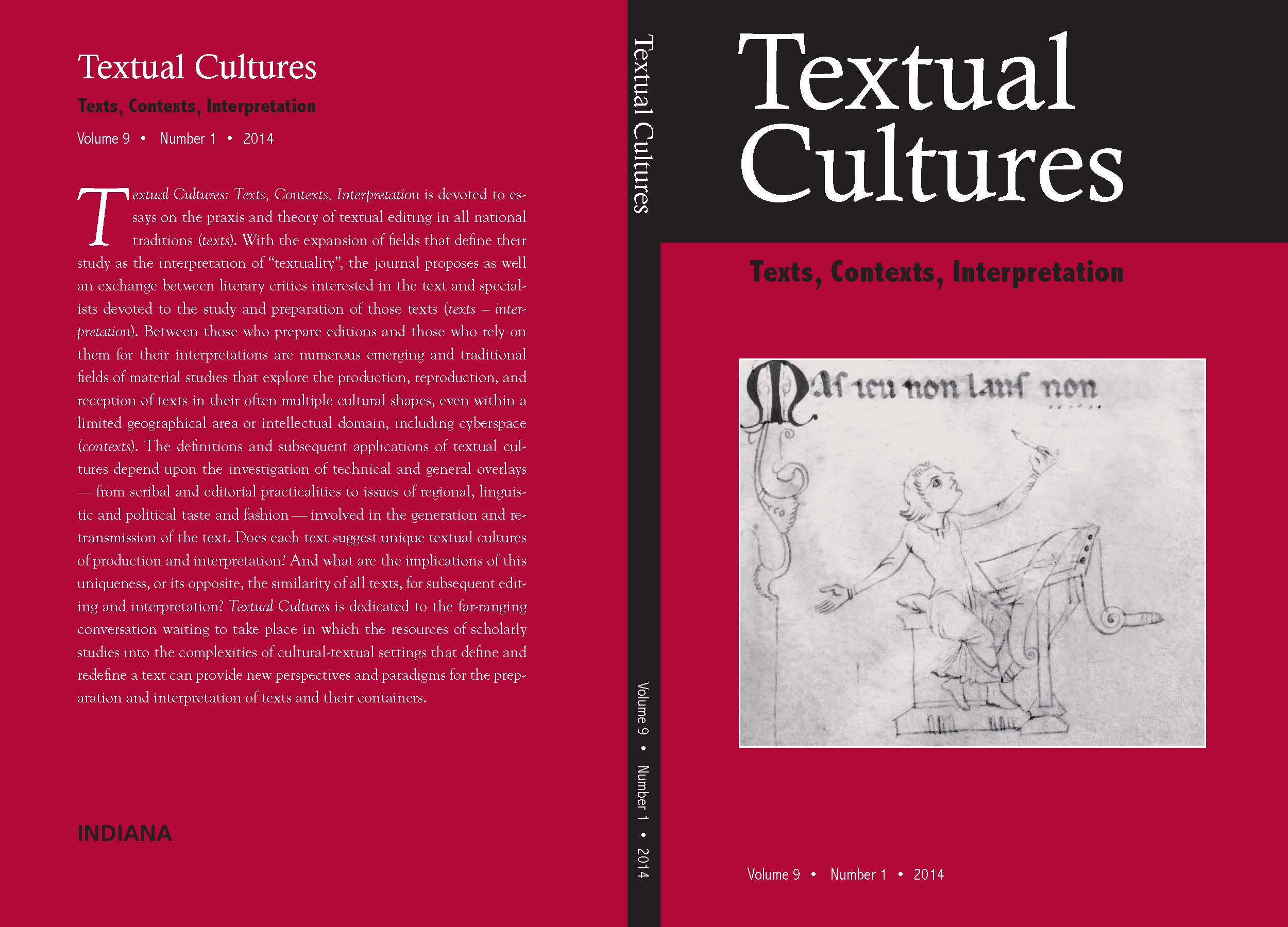Bédier’s Contribution to the Accomplishment of Stemmatic Method, An Italian Perspective
Main Article Content
Abstract
Downloads
Article Details
Authors who publish with this journal agree to the following terms:
- Authors retain copyright and grant the journal right of first publication with the work simultaneously licensed under a Creative Commons Attribution License (see:http://creativecommons.org/licenses/by/3.0/us/) that allows others to share the work with an acknowledgment of the work's authorship and initial publication in this journal.
- Authors warrant that their submission is their own original work, and that they have the right to grant the rights contained in this license. Authors also warrant that their submission does not, to the best of your knowledge, infringe upon anyone's copyright. If the submission contains material for which an author does not hold the copyright, authors warrant that they have obtained the unrestricted permission of the copyright owner to grant Indiana University the rights required by this license, and that such third-party owned material is clearly identified and acknowledged within the text or content of their submission.
- Authors are able to enter into separate, additional contractual arrangements for the non-exclusive distribution of the journal's published version of the work (e.g., post it to an institutional repository or publish it in a book), with an acknowledgment of its initial publication in this journal.
References
Armstrong, Edward C. et al. 1939. “Joseph Bédier”. Speculum 14: 411–12.
Bédier, Joseph, ed. 1890. [Jean Renart,] Le Lai de l’ombre. In Index lectionum quae in Universitate Friburgensi per menses aestivos anni MDCCCXC habebuntur. Fribourg: Imprimerie et Librairie de l’Oeuvre de Saint-Paul.
———, ed. 1913. Jean Renart, Le lai de l’ombre. Paris, Firmin-Didot.
———. 1928 (1929). “La tradition manuscrite du Lai de l’Ombre. Réflections sur l’art d’éditer les anciens textes”. Romania 54: 161–98, 321–56 (offprint Paris 1929).
Bourgain, Pascale, and Françoise Vielliard. 2002. Conseils pour l’édition des textes médiévaux. Fascicule III. Textes littéraires. Paris: Comité des travaux historiques et scientifiques. École nationale des chartes.
Collomp, Paul. 1931. La Critique des Textes. Paris: Les Belles Lettres.
Contini, Gianfranco. 1992. Breviario di ecdotica, 3d edition. Torino: Einaudi.
——— . 2 0 0 7. Frammenti di filologia romanza. Scritti di ecdotica e linguistica (1932–1989), a cura di Giancarlo Breschi. Firenze: SISMEL-Edizioni del Galluzzo, 2 vols.
Dembowski, Peter F. 1992–1993. “The ‘French’ Traditionof Textual Philology and Its Relevance to the Editing of Medieval Texts”. Modern Philology 9 0: 512 – 32.
Duval, Frédéric. 2006. “La philologie française, pragmatique avant tout? L’édition des textes médiévaux Français en France”. In Pratiques philologiques en Europe, études réunies par Frédéric Duval (Études et rencontres de l’École des chartes 21), 115–50. Paris: École des chartes.
Fiesoli, Giovanni. 2000. La genesi del lachmannismo. Firenze: Edizioni del Galluzzo.
Guidi, Vincenzo, and Paolo Trovato. 2004. “Sugli stemmi bipartiti. Decimazione, asimmetria e calcolo delle probabilità”. Filologia Italiana 1: 9– 48.
Italia, Paola. 2013. “Contini, Gianfranco”. Dizionario biografico degli italiani. http://www.treccani.it/enciclopedia/gianfranco-contini_(Dizionario-Biografico)/
Leonardi, Lino. 2011. “Il testo come ipotesi (critica del manoscritto-base)”. Medioevo romanzo 35: 5 –34.
Maas, Paul. 1958. Textual Criticism, translated by Barbara Flower. Oxford: At The Clarendon Press.
Nicolodi, Fiamma, and Paolo Trovato. 2003. “La tradizione primo ottocentesca dei libretti (1814–1830)”. Gioachino Rossini, Il Turco in Italia, a cura di Fiamma Nicolodi. Pesaro: Fondazione Rossini: LXI–CI.
Paris, Gaston. 1890. Review of Bédier 1890. Romania 19: 609–15.
Pasquali, Giorgio. 1952 [1934; rpt. 1974, 1988]. Storia della tradizione e critica del testo. Firenze: Le Monnier.
Rajna, Pio. 1929. “Un nuovo testo parziale del Saint Alexis p r i m it ivo”. Archivum Romanicum 13: 1–86.
Segre, Cesare, ed. 2003 [1989]. La Chanson de Roland, édition critique par C. Segre, nouvelle édition refondue. Traduite de l’italien par Madeleine Tyssens [. . .]. Glos-saire établi par Bernard Guidot. Genève: Droz.
Timpanaro, Sebastiano. 2005 [1963]. The Genesis of Lachmann’s Method, edited and translated by Glenn W. Most. Chicago: University Press.
Trovato, Paolo. 2013a. “Da Gaston Paris ai New Philologists. Qualche riflessione sul trattamento della veste linguistica nelle edizioni di testi romanzi”. In Transcrire et / ou traduire. Variation et changement linguistique dans la tradition manuscrite des textes médiévaux, Actes du congrès international, Klagenfurt, 15–16 novembre 2012, pub-liés par Raymund Wilhelm, 17–27. Heidelberg: Winter.
———. 2013b. “La tradizione manoscritta del Lai de l’ombre. Riflessioni sulle tecniche d’edizione primonovecentesche”. Romania 131: 338 – 8 0.
——— . 2 0 14 . Everything you Always Wanted to Know about Lachmann’s Method. A Non-Standard Handbook of Genealogical Textual Criticism in the Age of Post-Structuralism, Cladistics, and Copy-Text. Foreword by Michael D. Reeve. Padova: libreriauniver-sitaria.it.
Tudor, Adrian, ed. 2004. Jehan Renart, Le lai de l’ombre, translation and introduction by Adrian Tu d o r, text edited by Alan Hindley and Brian J. Levy. Liverpool: University of Liverpool, Department of French.
Weitzman, Michael. 1982. “Computer Simulation of the Development of Manu-script Traditions”. Bulletin of the Association for Literary and Linguistic Computing 10: 55 –59.
———. 1987. “The Evolution of the Manuscript Tradition”. Journal of the Royal Statisti-cal Society 150: 287–308.
